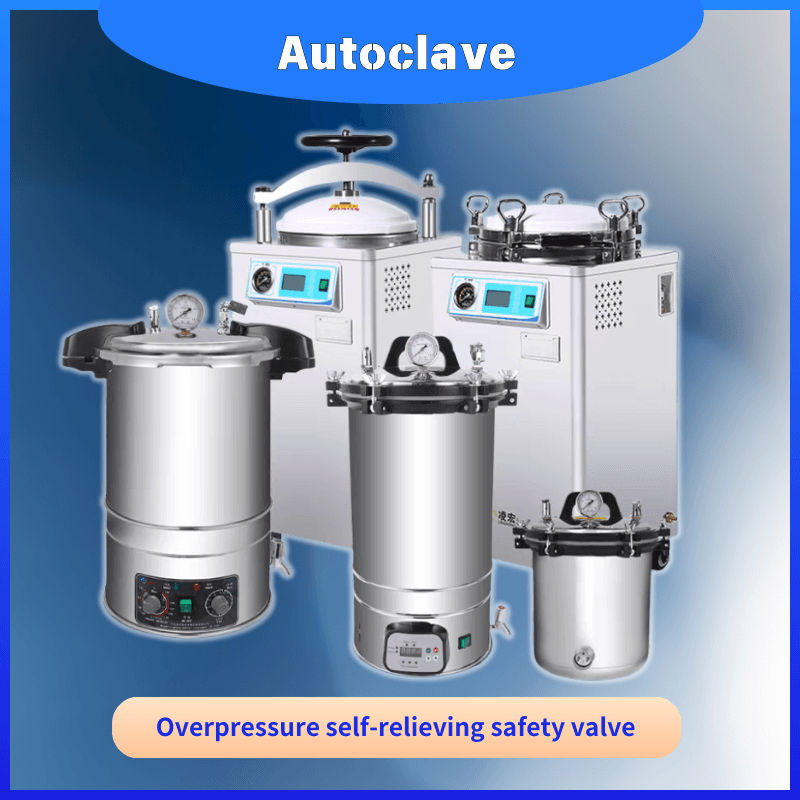
Saturated Steam Fundamentals:
Phase Diagram: [ P_{\text{sat}} = 10^{(A – \frac{B}{T + C})} ] The Antoine equation for water uses constants (A=8.07131), (B=1730.63), and (C=233.426) to calculate saturation pressure.
Critical Ratios:
| Temperature | Absolute Pressure | Steam Quality Requirement |
|---|---|---|
| 121°C | 2.1 bar (30.5 psi) | ≥97% dry saturated steam |
| 134°C | 3.0 bar (43.5 psi) | ≥99% dry saturated steam |
Interdependency Effects:
1 psi pressure drop → 1.3°C temperature decrease
Air entrapment at 5% level requires 30% more exposure time.
Standard Cycles:
| Cycle Type | Temp (°C) | Pressure (psi) | Time (min) | Aplicaciones |
|---|---|---|---|---|
| Gravity Displacement | 121 | 15-17 | 30 | Glassware, textiles |
| Pre-Vacuum | 134 | 29-32 | 4 | Lumened instruments |
| Liquids (Slow Exhaust) | 121 | 15-17 | 45 | Culture media |
| Flash | 134 | 29-32 | 3 | Emergency instruments |
Material-Specific Limits:
| Material | Max Temp | Max Pressure | Cycle Restrictions |
|---|---|---|---|
| Polycarbonate | 135°C | 25 psi | Avoid liquid cycles |
| PTFE | 260°C | 75 psi | All cycles permitted |
| Silicone Rubber | 150°C | 45 psi | Max 15 cycles/day |
Temperature Sensors:
| Type | Accuracy | Response Time | Placement Strategy |
|---|---|---|---|
| Fiber Optic Probes | ±0.1°C | 0.5 sec | Direct contact with load |
| Wireless Loggers | ±0.3°C | 2 sec | Inside sterilization pouches |
| Infrared Sensors | ±0.5°C | 0.1 sec | Chamber wall-mounted array |
Pressure Regulation:
PID Controllers: Maintain ±0.2 psi accuracy
The triple safety valves operate at a setting of 110% above the normal operating pressure.
Leak Testing: ≤1 mbar/min (EN 285 standard)
Performance Qualification (PQ):
Heat Distribution Test:
30 thermocouples, 3 consecutive runs
Acceptance: All points ≥121°C ±1°C
Heat Penetration Test:
Simulated worst-case load (stainless steel tubes)
Fo = 15 minutes at 121°C equivalent
Biological Challenge:
Geobacillus stearothermophilus (1×10⁶ spores)
Incubation: 56°C for 7 days
Documentation Requirements:
Real-time data logging (temperature/pressure every 5 seconds)
Calibration certificates (NIST-traceable)
Annual requalification reports
Pressure-Temperature Mismatches:
| Symptom | Root Cause | Corrective Action |
|---|---|---|
| High pressure, low temp | Air pockets in chamber | Extend pre-vacuum phase |
| Low pressure, high temp | Steam superheating | Install steam moisture separator |
| Rapid pressure swings | Faulty PRV | Replace pressure relief valve |
Case Study: The biotechnology lab managed to reduce wet packs by 91%.
The biotech lab enhanced its drying phase by setting the pressure to -0.7 bar in a vacuum environment.
The tray load weight decreased from 8 kg to 5 kg.
Installing dual moisture sensors in exhaust line
An autoclave achieves its best performance when temperature-pressure parameters remain within ±1°C and ±2% of their predetermined setpoints. By using IoT technology for monitoring and predictive algorithms sterilization failures drop by 78% and energy consumption decreases by 25%. The upcoming ISO/AWI 54226 (2025) standard will require real-time parametric release which makes precise parameter control necessary.
Q1: How does pressure become important when temperature alone can achieve sterilization? A: A lack of adequate pressure at 121°C leads to superheated steam which cannot penetrate microorganisms effectively.
Q2: To determine sterilization time across various pressures you need to apply the (F_0) formula. Use the (F_0) formula: [ F_0 = \Delta t \times 10^{(T – 121)/10} ] Example: The equivalent sterilization time for 10 minutes at 126°C computes to (10 \times 10^{(126-121)/10} = 31.6) minutes.
Q3: What pressure compensates for high altitude sterilization? At 2,000m elevation: [ P{\text{adj}} = P{\text{sea}} \times \left(1 + \frac{\text{Elevation (m)}}{6,500}\right) ] For 121°C: 15 psi → 17.3 psi
Q4: Is it possible to achieve sterilization by autoclaving at reduced temperatures for extended durations? Yes, using the formula: [ t_2 = t_1 \times 10^{(T_1 – T_2)/Z} ] For Z=10°C: 121°C/15min ≈ 134°C/2min
Q5: How often should pressure gauges be calibrated? Per ISO 17665:
Monthly checks with deadweight tester
Full recalibration every 6 months

The healthcare industry requires strict adherence to sterile conditions to protect patients from infections and maintain safety standards alongside regulatory compliance. Medical equipment dealers, distributors, and procurement specialists must understand

A fundamental aspect of infection control in health care systems revolves around sterilization to eliminate dangerous microorganisms from medical instruments and materials which both safeguards patients and adheres to strict

Medical facilities must prioritize sterility to prevent infections and protect patients while following strict regulatory guidelines. Medical equipment dealers, distributors, and procurement specialists who understand the function of autoclaves can

In medical settings sterilization remains a critical procedure which removes dangerous microorganisms from instruments and supplies to protect patients and maintain strict safety protocols. Medical equipment dealers, distributors and procurement

Healthcare infection control depends on sterilization to make medical instruments and materials safe from harmful microorganisms while upholding patient safety and strict regulatory standards. Medical equipment dealers, distributors and procurement

The sterilization process plays an essential role in healthcare by eliminating harmful microorganisms from medical instruments which ensures patient safety and meets strict regulatory requirements. Medical equipment dealers, distributors and